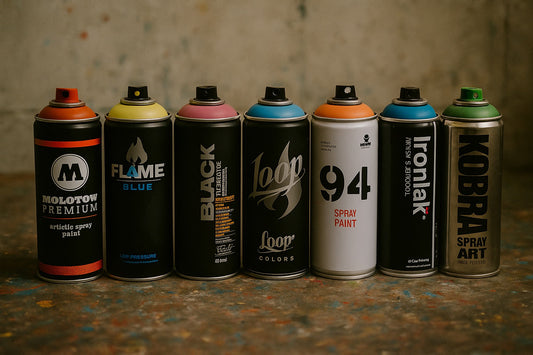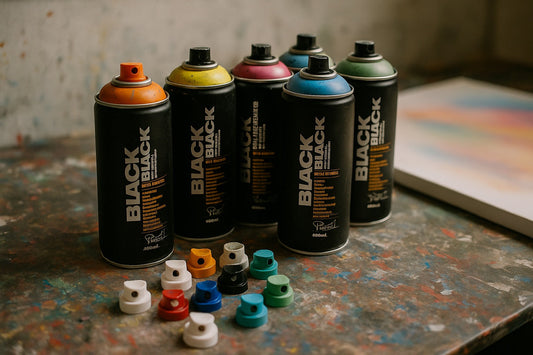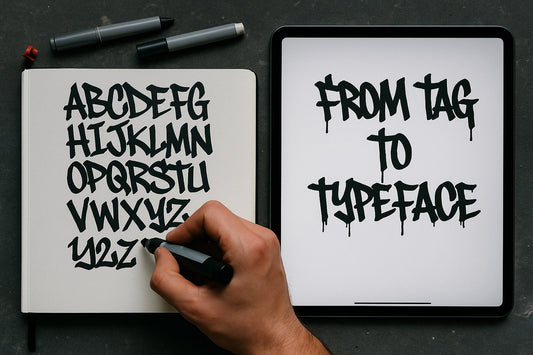
How to Start Graffiti at Home: 10 Powerful Steps for Beginners
Share
Introduction
Ever looked at a vibrant graffiti wall and thought, “I want to try that”? You’re not alone. Graffiti has grown from an underground street movement into a respected form of self-expression found in galleries, fashion, and home décor. The good news? You don’t need to hit the streets to get started. With the right tools, mindset, and a little creative hustle, you can begin your graffiti journey from the comfort of your own home. This guide breaks down everything you need to know about gear, techniques, style, and culture in 10 actionable steps to help you unleash your inner graffiti artist.
1. Understand the Culture Before You Paint
Graffiti isn’t just paint on walls, it’s a culture rooted in self-expression, identity, and rebellion. Born in the streets of New York during the 1970s, it grew into a worldwide movement. Before you grab a spray can, immerse yourself in the culture. Watch documentaries like Style Wars or browse graffiti forums and Instagram pages. Understanding the history helps you respect the art form and inspires you to push your own boundaries.
At home, this foundation matters. You’re not just painting shapes, you’re tapping into a living legacy of creativity. By learning the lingo (tags, throw-ups, burners) and appreciating its evolution, your art gains depth and meaning.
2. Gather the Essential Graffiti Tools
To start graffiti at home, you’ll need more than just spray paint. Basic supplies include:
- Spray paint (brands like Montana, Loop, or Molotow)
- Paint markers for detailing
- A sketchbook for planning designs
- Protective gloves and a mask for safety
If you’re new, grab a beginner-friendly spray set with a variety of caps (fat caps for fills, skinny caps for details). The beauty of practising at home is that you can experiment without pressure. Invest in quality tools early, and you’ll notice the difference in flow, opacity, and overall results.
3. Create a Safe Practice Space
Not everyone has a backyard wall to paint on, so creativity is key. Large cardboard sheets, wooden panels, or even old canvas work perfectly as practice surfaces. If you want to go eco-friendly, reuse shipping boxes or thrifted furniture pieces.
Set up in a ventilated area like a garage or outdoor patio. Lay down tarps to avoid a mess and wear old clothes. The more comfortable and safe your space feels, the easier it will be to lose yourself in the process and build consistency.

4. Master the Art of Tagging
Every graffiti journey begins with a tag, your personal signature. It’s the rawest, most authentic mark of identity in the graffiti world. Start by experimenting in a sketchbook. Play with letter spacing, angles, drips, and flourishes until you find something that feels yours.
When you practice on larger surfaces, focus on flow. Smooth wrist movements create cleaner lines, while hesitation often shows in the paint. Remember, your tag is your brand it should be unique, memorable, and consistent across surfaces.
5. Experiment With Sketching & Blackbooks
Graffiti artists rely on blackbooks (sketchbooks) to refine ideas before hitting a wall. This practice keeps you sharp and ensures your spray paint sessions are more intentional. Start with bubble letters or blocky styles, then evolve into wildstyle or more abstract approaches.
Sketching at home helps you find your rhythm without wasting paint. Plus, it becomes a personal archive of your growth, you’ll look back one day and see how far your style has evolved. Treat your blackbook as a graffiti diary where no idea is too small or too wild.
6. Learn Can Control Like a Pro
Spray paint is powerful, but it takes time to master. Beginners often struggle with drips, overspray, and uneven fills. To improve, practice the basics:
- Distance: Keep the can about 6–12 inches from the surface.
- Pressure: Experiment with light vs. heavy finger pressure.
- Speed: Slow for fills, fast for clean outlines.
Set aside sessions just for practising straight lines, fades, and dots. The more you train, the more control you’ll gain. Think of it like learning scales on a guitar; the basics unlock your ability to freestyle confidently later.
7. Play With Colour and Effects
Graffiti is all about bold, eye-catching visuals. Start experimenting with colour combinations, contrasting shades for impact, or complementary tones for harmony. Don’t shy away from neon, metallic, or matte finishes to push your work further.
Effects like fades, 3D shadows, and drips can elevate your pieces from amateur to standout. A simple two-colour fade can transform basic block letters into a striking design. Test combinations in your black book first before committing them to larger work.
8. Draw Inspiration From the Streets
Even if you’re practising at home, keep your eyes open when walking through your city. Street walls, trains, and alleyways are filled with inspiration. Notice how artists layer tags, balance colours, and use negative space.
Capture photos and build your own reference library. Then, reinterpret these influences in your home practice. Inspiration fuels creativity, but originality keeps your art respected. Remember: borrow techniques, but always remix them into something authentically yours.
9. Respect Legal Boundaries While Growing
One of the biggest appeals of practising graffiti at home is avoiding the legal risks tied to street bombing. Use your personal space as a playground where you can grow freely. If you do want to transition outside, research legal walls or graffiti-friendly events in your city.
This step keeps your journey sustainable. Instead of worrying about fines or getting caught, you can focus purely on levelling up your skills. As your work improves, you’ll find more opportunities to showcase it in legitimate art shows, local businesses, or even commissions.
10. Stay Consistent & Build Your Style
Graffiti is a marathon, not a sprint. The most respected artists didn’t get there overnight; they stayed consistent, practised daily, and pushed their style further with every piece. Dedicate time each week to sketching, tagging, or painting at home.
Over time, patterns in your work will emerge: your preferred letter shapes, signature drips, and unique flourishes. That’s your style. Nurture it, refine it, and don’t be afraid to reinvent yourself when inspiration strikes. Consistency is how you turn from a beginner into a name worth remembering.
Conclusion
Starting graffiti at home is more than learning to spray, it’s about joining a culture, developing a voice, and pushing creative limits. From your first shaky tag in a sketchbook to bold experiments on cardboard walls, every step matters. The key is patience, practice, and respect for the art form. Whether you want to stay home-based or eventually take your art to the streets, graffiti offers a limitless canvas for self-expression. So grab a can, claim your space, and start creating today.



